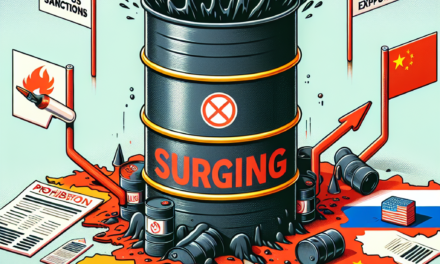“Wall Street Soars: Trump’s Triumph Ignites a Bullish Frenzy”
Introduction
Following the unexpected victory of Donald Trump in the U.S. presidential election, Wall Street experienced a significant surge, marking a shift to full risk-on mode among investors. The markets, initially bracing for volatility, quickly pivoted as traders and analysts reassessed the potential economic implications of a Trump administration. Optimism surrounding proposed tax cuts, deregulation, and infrastructure spending fueled a rally across major indices, with sectors such as financials, industrials, and materials leading the charge. This newfound investor confidence underscored a broader market sentiment that anticipated robust economic growth and increased corporate profitability under the new political landscape.
Impact Of Trump’s Victory On Wall Street’s Risk Appetite
The unexpected victory of Donald Trump in the presidential election has sent ripples through global financial markets, with Wall Street experiencing a significant surge as investors embrace a full risk-on mode. This shift in sentiment marks a stark contrast to the initial uncertainty that gripped markets in the lead-up to the election. As the dust settles, it becomes increasingly clear that Trump’s pro-business stance and promises of deregulation, tax cuts, and infrastructure spending have invigorated investor confidence, prompting a robust rally in equities.
In the immediate aftermath of the election, futures markets initially plummeted, reflecting widespread apprehension about the potential implications of a Trump presidency. However, as investors began to digest the potential economic policies of the new administration, sentiment quickly shifted. The prospect of corporate tax reform and reduced regulatory burdens has been particularly appealing to investors, who anticipate that these measures could stimulate economic growth and boost corporate profits. Consequently, sectors such as financials, industrials, and energy have experienced notable gains, as they stand to benefit directly from Trump’s proposed policies.
Moreover, the anticipation of increased fiscal spending on infrastructure projects has further fueled optimism among investors. The expectation is that such spending will not only create jobs but also stimulate demand for materials and services, thereby benefiting companies involved in construction, engineering, and related industries. This has led to a surge in the stock prices of firms within these sectors, as market participants position themselves to capitalize on potential opportunities.
In addition to domestic factors, the global context has also played a role in shaping Wall Street’s response to Trump’s victory. With central banks around the world maintaining accommodative monetary policies, the search for yield has driven investors towards equities, which are perceived as offering better returns compared to low-yielding bonds. This has further amplified the risk-on sentiment, as investors seek to maximize returns in an environment characterized by historically low interest rates.
However, it is important to note that while the initial reaction has been overwhelmingly positive, uncertainties remain. Questions linger regarding the implementation and effectiveness of Trump’s proposed policies, as well as their potential impact on the broader economy. Additionally, geopolitical risks and trade tensions could pose challenges to sustained market growth. Despite these concerns, the prevailing sentiment on Wall Street is one of cautious optimism, as investors weigh the potential benefits of a pro-business administration against the inherent risks.
Furthermore, the Federal Reserve’s monetary policy trajectory will be closely monitored, as any changes in interest rates could influence market dynamics. A potential rate hike could temper the current exuberance, as higher borrowing costs might impact corporate profitability and consumer spending. Nevertheless, the overall outlook remains positive, with many analysts predicting continued strength in equities as long as economic fundamentals remain supportive.
In conclusion, the election of Donald Trump has undeniably sparked a significant shift in Wall Street’s risk appetite, with investors embracing a more optimistic outlook in anticipation of pro-growth policies. While challenges and uncertainties persist, the prevailing sentiment is one of cautious optimism, as market participants navigate the evolving landscape. As the new administration takes shape, the focus will remain on policy implementation and its implications for the economy, with investors keenly attuned to any developments that could influence market dynamics.
Analyzing The Market Surge Post-Trump Election
The recent surge on Wall Street following Donald Trump’s election victory has captured the attention of investors and analysts alike, as markets have entered a full risk-on mode. This phenomenon, characterized by a robust appetite for riskier assets, has been driven by a confluence of factors that have reshaped investor sentiment and market dynamics. To understand the underlying causes of this market surge, it is essential to examine the economic policies proposed by Trump, the psychological impact on investors, and the broader implications for global markets.
Firstly, Trump’s victory has been perceived by many investors as a catalyst for pro-growth economic policies. His administration’s promises of tax cuts, deregulation, and increased infrastructure spending have fueled optimism about the potential for accelerated economic growth. These policy proposals are expected to stimulate corporate earnings and boost consumer spending, thereby creating a favorable environment for equities. Consequently, sectors such as financials, industrials, and materials have experienced significant gains, as investors anticipate that these industries will benefit most from the proposed policy changes.
Moreover, the psychological impact of Trump’s victory cannot be underestimated. The election outcome has instilled a sense of certainty and direction, which had been lacking in the months leading up to the election. This newfound clarity has alleviated some of the uncertainty that typically weighs on markets, prompting investors to reallocate capital towards riskier assets. The shift in sentiment is evident in the rally of major stock indices, with the Dow Jones Industrial Average and the S&P 500 reaching record highs in the days following the election.
In addition to domestic factors, the global market landscape has also played a role in the post-election surge. The anticipation of a more business-friendly U.S. administration has led to a strengthening of the U.S. dollar, which has implications for international trade and investment flows. A stronger dollar can attract foreign investment into U.S. assets, further bolstering market performance. However, it is important to note that a stronger dollar can also pose challenges for U.S. exporters, as it makes American goods more expensive abroad.
Furthermore, the bond market has reacted to the election outcome with a notable increase in yields. The prospect of higher government spending and potential inflationary pressures has led investors to adjust their expectations for future interest rates. As a result, bond prices have declined, and yields have risen, reflecting the market’s anticipation of a shift in monetary policy. This development has implications for fixed-income investors, who may need to reassess their strategies in light of changing interest rate dynamics.
While the initial market reaction to Trump’s victory has been overwhelmingly positive, it is crucial to consider the potential risks and uncertainties that lie ahead. The implementation of proposed policies may face challenges in Congress, and geopolitical tensions could introduce volatility into the markets. Additionally, the long-term impact of these policies on economic growth and income inequality remains a subject of debate among economists.
In conclusion, the surge on Wall Street following Trump’s election victory can be attributed to a combination of pro-growth policy expectations, improved investor sentiment, and favorable global market conditions. As markets continue to navigate this new landscape, investors will need to remain vigilant and adaptable to the evolving economic and political environment. The coming months will be critical in determining whether the current risk-on mode is sustainable or merely a temporary reaction to the election outcome.
Investor Sentiment Shifts: Trump And Wall Street
In the wake of Donald Trump’s unexpected electoral victory, Wall Street has experienced a significant surge, marking a pronounced shift in investor sentiment. This development has ushered in a full risk-on mode, characterized by a robust appetite for equities and other riskier assets. The initial reaction to Trump’s win was one of uncertainty, with futures markets indicating a potential downturn. However, as investors began to digest the implications of his proposed economic policies, optimism took hold, driving a rally across major indices.
Central to this shift in sentiment is the anticipation of Trump’s pro-business agenda, which includes promises of tax cuts, deregulation, and substantial infrastructure spending. These policy proposals have been warmly received by investors, who foresee a more favorable business environment that could stimulate economic growth. The prospect of reduced corporate taxes, in particular, has been a key driver of market enthusiasm, as it is expected to boost corporate earnings and, consequently, stock valuations.
Moreover, the financial sector has been one of the primary beneficiaries of this newfound optimism. Banks and financial institutions have seen their stock prices soar, buoyed by the expectation of deregulation and rising interest rates. Trump’s administration is perceived as more lenient towards Wall Street, potentially rolling back some of the stringent regulations imposed after the 2008 financial crisis. This regulatory relief is anticipated to enhance profitability within the sector, further fueling investor confidence.
In addition to the financial sector, industrial and infrastructure-related stocks have also experienced significant gains. Trump’s commitment to revitalizing America’s infrastructure has sparked interest in companies poised to benefit from increased government spending on construction and development projects. This has led to a rally in stocks related to construction materials, machinery, and engineering services, as investors position themselves to capitalize on potential opportunities.
However, it is important to note that this surge in investor sentiment is not without its risks. While the market’s initial reaction has been overwhelmingly positive, there remains a degree of uncertainty surrounding the implementation and effectiveness of Trump’s policies. The potential for trade tensions, particularly with key economic partners, could pose challenges to global economic stability. Additionally, the impact of increased government spending on the national debt and inflation rates remains a concern for some investors.
Despite these uncertainties, the prevailing mood on Wall Street is one of cautious optimism. Investors are closely monitoring the unfolding political landscape, seeking clarity on policy details and timelines. In the meantime, the market’s upward trajectory reflects a broader confidence in the resilience of the U.S. economy and its ability to adapt to new leadership.
In conclusion, Donald Trump’s victory has undeniably shifted investor sentiment, propelling Wall Street into a full risk-on mode. The anticipation of pro-business policies has sparked a rally across various sectors, with financials and infrastructure-related stocks leading the charge. While challenges and uncertainties remain, the current market environment underscores a renewed sense of optimism and opportunity. As investors navigate this evolving landscape, the focus will remain on the administration’s ability to deliver on its promises and the broader implications for the global economy.
Sectors Benefiting From Trump’s Economic Policies

The election of Donald Trump as President of the United States has ushered in a new era of economic policies that have significantly impacted various sectors on Wall Street. As investors adjust to the anticipated changes, the market has experienced a surge, with a pronounced shift towards a full risk-on mode. This shift is largely driven by expectations of deregulation, tax reforms, and increased infrastructure spending, which are central to Trump’s economic agenda. Consequently, several sectors are poised to benefit from these policies, leading to heightened investor interest and activity.
One of the primary sectors expected to thrive under Trump’s administration is the financial sector. The promise of deregulation, particularly the potential rollback of the Dodd-Frank Act, has been met with enthusiasm by banks and financial institutions. This regulatory relief is anticipated to reduce compliance costs and increase profitability, thereby encouraging lending and investment activities. As a result, financial stocks have seen a notable uptick, reflecting investor optimism about the sector’s future performance.
In addition to the financial sector, the energy sector stands to gain significantly from Trump’s policies. His administration’s focus on energy independence and support for fossil fuels, including coal, oil, and natural gas, is expected to boost domestic production. The easing of environmental regulations and the approval of key infrastructure projects, such as pipelines, are likely to enhance the sector’s growth prospects. Consequently, energy companies are experiencing increased investor interest, as they are well-positioned to capitalize on these favorable policy shifts.
Moreover, the industrial sector is set to benefit from Trump’s proposed infrastructure spending. The administration’s commitment to revitalizing America’s infrastructure through substantial investment in roads, bridges, and airports is expected to create a surge in demand for construction materials and machinery. This anticipated increase in infrastructure projects is likely to drive growth in the industrial sector, as companies involved in construction and manufacturing stand to gain from the heightened activity.
Furthermore, the defense sector is poised for growth under Trump’s presidency. His emphasis on strengthening national security and increasing defense spending is expected to result in higher government contracts for defense companies. This focus on military expansion and modernization is likely to boost revenues for firms involved in the production of defense equipment and technology, thereby attracting investor interest in the sector.
While these sectors are positioned to benefit from Trump’s economic policies, it is important to note that the broader market sentiment remains influenced by various factors, including geopolitical developments and global economic conditions. Nevertheless, the initial response to Trump’s victory has been characterized by a surge in market activity, as investors anticipate the potential benefits of his pro-business agenda.
In conclusion, the election of Donald Trump has sparked a significant shift in market dynamics, with several sectors poised to benefit from his economic policies. The financial, energy, industrial, and defense sectors are among those expected to experience growth as a result of deregulation, infrastructure spending, and increased defense budgets. As Wall Street continues to navigate this new landscape, investors remain focused on the opportunities presented by these policy changes, driving a full risk-on mode in the market.
Historical Comparisons: Market Reactions To Presidential Elections
The financial markets have long been sensitive to political events, with presidential elections often serving as pivotal moments that can lead to significant market movements. The recent surge on Wall Street following Donald Trump’s victory is a testament to this phenomenon, as investors quickly shifted into a full risk-on mode. To understand the implications of this reaction, it is instructive to examine historical comparisons of market responses to presidential elections, which reveal patterns and insights into investor behavior.
Historically, the stock market’s reaction to presidential elections has varied, often depending on the perceived economic policies of the incoming administration. For instance, the election of Franklin D. Roosevelt in 1932, during the depths of the Great Depression, initially led to market uncertainty. However, as his New Deal policies began to take shape, investor confidence gradually improved, resulting in a sustained market rally. Similarly, the election of Ronald Reagan in 1980 was met with optimism due to his pro-business stance, leading to a bull market that lasted throughout much of the 1980s.
In contrast, the election of Barack Obama in 2008 occurred amidst the global financial crisis, and the market’s initial reaction was one of caution. However, as his administration implemented measures to stabilize the economy, including the Troubled Asset Relief Program (TARP) and the American Recovery and Reinvestment Act, investor sentiment improved, and the market began a prolonged recovery. These examples illustrate that while initial reactions can be volatile, markets often adjust as the new administration’s policies become clearer.
Turning to the recent election of Donald Trump, the market’s response was swift and pronounced. Investors appeared to focus on his promises of tax cuts, deregulation, and infrastructure spending, which were perceived as favorable for economic growth and corporate profits. This optimism was reflected in the surge of stock prices, particularly in sectors such as financials and industrials, which were expected to benefit from the anticipated policy changes. The market’s reaction can be seen as a classic example of a risk-on environment, where investors are willing to take on more risk in pursuit of higher returns.
However, it is important to note that while the initial market reaction was positive, the long-term impact of a presidential election on the stock market is influenced by a multitude of factors, including global economic conditions, geopolitical events, and the actual implementation of proposed policies. For instance, while Trump’s election initially sparked a rally, subsequent developments such as trade tensions and geopolitical uncertainties have introduced volatility and complexity into the market landscape.
In conclusion, the historical comparisons of market reactions to presidential elections highlight the intricate relationship between politics and finance. While initial market responses can be driven by expectations and sentiment, the longer-term trajectory is shaped by a broader set of factors. As investors navigate the evolving political and economic environment, understanding these historical patterns can provide valuable insights into potential market dynamics. The recent surge on Wall Street following Trump’s victory serves as a reminder of the market’s sensitivity to political change and the importance of considering both immediate reactions and longer-term implications.
The Role Of Fiscal Policies In Wall Street’s Bull Run
The recent surge on Wall Street, following the unexpected victory of Donald Trump in the presidential election, has brought fiscal policies to the forefront of discussions regarding the current bull run. Investors have been quick to react to the anticipated changes in fiscal policy, which are expected to significantly impact the economic landscape. As the market embraces a full risk-on mode, it is crucial to understand the role of fiscal policies in driving this bullish sentiment.
Fiscal policies, which encompass government spending and taxation decisions, play a pivotal role in shaping economic growth and investor confidence. In the wake of Trump’s victory, expectations of substantial fiscal stimulus have fueled optimism among market participants. The proposed tax cuts, increased infrastructure spending, and deregulation are seen as catalysts for economic expansion, prompting investors to reassess their portfolios and increase their exposure to riskier assets.
One of the primary drivers of the current bull run is the anticipated corporate tax reform. Lowering the corporate tax rate is expected to boost corporate profits, thereby enhancing shareholder value. This potential increase in profitability has led to a surge in stock prices, as investors anticipate higher earnings and dividends. Moreover, the repatriation of overseas profits, facilitated by favorable tax policies, is likely to result in increased capital investment and share buybacks, further supporting the upward trajectory of the stock market.
In addition to tax reforms, the promise of increased infrastructure spending has also contributed to the positive sentiment on Wall Street. Infrastructure projects are expected to create jobs and stimulate economic activity, leading to higher consumer spending and business investment. This anticipated boost in economic growth has encouraged investors to allocate more capital to sectors poised to benefit from such developments, including construction, materials, and industrials.
Furthermore, the prospect of deregulation under the Trump administration has been met with enthusiasm by investors. Easing regulatory burdens is expected to enhance business efficiency and profitability, particularly in sectors such as finance, energy, and healthcare. The potential for reduced compliance costs and increased operational flexibility has led to a revaluation of companies within these industries, driving stock prices higher.
However, it is important to acknowledge the potential risks associated with these fiscal policies. While the market has reacted positively to the anticipated changes, there remains uncertainty regarding the implementation and effectiveness of these measures. The possibility of increased government debt and inflationary pressures could pose challenges to sustained economic growth. Additionally, geopolitical tensions and trade policies may introduce volatility and impact investor sentiment.
Despite these uncertainties, the current market environment reflects a strong belief in the positive impact of fiscal policies on economic growth. The shift towards a risk-on mode is indicative of investor confidence in the potential for increased corporate earnings and economic expansion. As Wall Street continues its upward trajectory, the role of fiscal policies in sustaining this bull run will remain a focal point for market participants.
In conclusion, the recent surge on Wall Street, driven by expectations of significant fiscal policy changes under the Trump administration, underscores the critical role of government spending and taxation decisions in shaping market dynamics. While the current optimism is fueled by anticipated tax reforms, infrastructure spending, and deregulation, it is essential to remain vigilant of potential risks and challenges. As investors navigate this evolving landscape, the interplay between fiscal policies and market performance will continue to be a key determinant of Wall Street’s trajectory.
Long-Term Implications Of Trump’s Presidency On Financial Markets
The election of Donald Trump as the President of the United States marked a significant turning point for financial markets, ushering in a period of heightened optimism and volatility. Wall Street’s immediate reaction to Trump’s victory was a surge in stock prices, reflecting a full risk-on mode as investors anticipated pro-business policies and regulatory rollbacks. This initial exuberance was driven by expectations of tax cuts, infrastructure spending, and deregulation, which were seen as catalysts for economic growth and corporate profitability. However, while the short-term market response was overwhelmingly positive, the long-term implications of Trump’s presidency on financial markets are more nuanced and complex.
To begin with, Trump’s economic policies were expected to stimulate growth, but they also introduced a degree of uncertainty. The promise of tax reform and reduced regulation was music to the ears of investors, particularly in sectors such as finance, energy, and manufacturing. These industries were poised to benefit from a more business-friendly environment, potentially leading to increased investment and job creation. However, the administration’s protectionist trade stance, characterized by tariffs and renegotiation of trade agreements, posed risks to global supply chains and international trade relations. This created a dichotomy where domestic-focused companies might thrive, while those reliant on global markets faced headwinds.
Moreover, Trump’s presidency brought about significant changes in fiscal policy, with a shift towards expansionary measures. The anticipated increase in government spending, particularly on infrastructure, was expected to boost economic activity. However, this also raised concerns about rising budget deficits and national debt levels. The potential for higher interest rates, as the Federal Reserve responded to inflationary pressures, could have implications for borrowing costs and investment decisions. Thus, while fiscal stimulus might drive short-term growth, the long-term sustainability of such policies remained a topic of debate among economists and market participants.
In addition to fiscal and trade policies, Trump’s approach to regulation had profound implications for financial markets. The administration’s efforts to roll back regulations, particularly those imposed on the financial sector following the 2008 financial crisis, were seen as a boon for banks and financial institutions. This deregulation was expected to enhance profitability by reducing compliance costs and increasing lending capacity. However, it also raised concerns about the potential for increased risk-taking and the possibility of future financial instability. Balancing the benefits of deregulation with the need for prudent oversight became a critical consideration for policymakers and investors alike.
Furthermore, Trump’s presidency highlighted the importance of geopolitical factors in shaping financial markets. The administration’s foreign policy decisions, including relations with China, North Korea, and the Middle East, had the potential to influence market sentiment and volatility. Geopolitical tensions could lead to fluctuations in commodity prices, currency valuations, and investor confidence, underscoring the interconnectedness of global markets.
In conclusion, while Trump’s victory initially sparked a surge in Wall Street and a full risk-on mode, the long-term implications of his presidency on financial markets are multifaceted. The interplay of fiscal policy, trade dynamics, regulatory changes, and geopolitical factors creates a complex landscape for investors to navigate. As such, understanding these elements and their potential impact is crucial for making informed investment decisions in an era marked by both opportunity and uncertainty.
Q&A
1. **What was the immediate market reaction to Trump’s victory?**
The immediate market reaction was a significant surge in stock prices as investors embraced a full risk-on mode, anticipating pro-business policies.
2. **Which sectors benefited the most from the Trump victory?**
Financials, industrials, and healthcare sectors saw the most significant gains, driven by expectations of deregulation and infrastructure spending.
3. **How did the bond market respond to the election results?**
The bond market experienced a sell-off, leading to rising yields as investors anticipated higher inflation and increased government borrowing.
4. **What was the impact on the U.S. dollar following the election?**
The U.S. dollar strengthened significantly against other currencies, reflecting investor confidence in the U.S. economy under Trump’s presidency.
5. **How did global markets react to Trump’s victory?**
Global markets had mixed reactions, with some experiencing volatility and others rallying in response to the U.S. market surge.
6. **What were investors’ expectations regarding Trump’s economic policies?**
Investors expected tax cuts, deregulation, and increased infrastructure spending, which were seen as positive for economic growth.
7. **How did Trump’s victory influence investor sentiment?**
Investor sentiment turned optimistic, with a shift towards riskier assets as confidence in economic growth and corporate profitability increased.
Conclusion
The election of Donald Trump as President of the United States triggered a significant surge on Wall Street, characterized by a full risk-on mode among investors. This reaction was driven by expectations of pro-business policies, including tax cuts, deregulation, and increased infrastructure spending, which were anticipated to stimulate economic growth and corporate profitability. The market’s optimism was reflected in rising stock prices, particularly in sectors like financials and industrials, which were expected to benefit most from the new administration’s agenda. However, this initial enthusiasm also carried potential risks, such as increased volatility and uncertainty regarding the implementation and long-term effects of these policies. Overall, Trump’s victory marked a pivotal moment for financial markets, underscoring the complex interplay between politics and economic sentiment.





